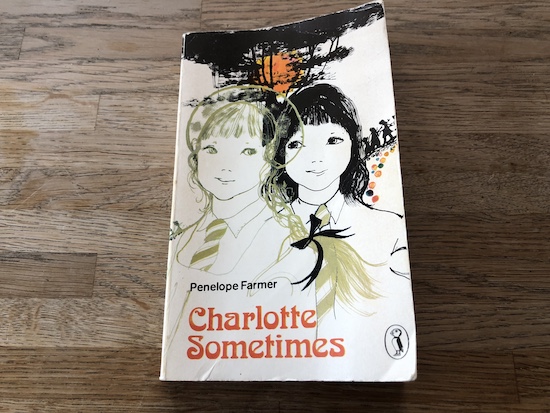Night after night she lay alone in bed / Her eyes so open to the dark / The streets all looked so strange / They seemed so far away / But Charlotte did not cry… – ‘Charlotte Sometimes’ (single) – Robert Smith/Penelope Farmer
Charlotte Sometimes was one of the first books to make me think about myself growing up. It brought to mind the younger person I used to be, approaching adolescence, navigating the constant fracturing and rebuilding of my identity. It also made me realise that this was a process I never fully left behind, that I would, I will, never truly escape.
I was in my late twenties to early thirties when I bought it, on a trip to Bristol to see my baby brother, James, eleven years my junior, who was six when I left home, but now was suddenly, miraculously, at university. I’d gone to the Oxfam second-hand bookshop in Clifton to donate my Chaucer companion and a few anthologies of poetry and plays from my English degree. I’d struggled with the idea of giving them away as ten years earlier they’d been a big part of who I wanted to be: a fish out of water in a fancy old university trying to look clever. I didn’t want to feel like her any more. I wanted to cut off that character, become someone else.
On the same day that I left them (or they left me), Charlotte appeared on the top of a bookcase, facing the front window. This version of Charlotte Sometimes was the very first paperback edition, published by Puffin in 1972, with two girls on the cover, drawn in sparse pencil strokes – one black, one dull gold – by Janina Ede. The drawings inside by another illustrator, Chris Connor, were similarly woozy: a girl on a bed in inky blotches, others at strange angles, their faces barely defined.
Of course, the reason I bought this in the first place was The Cure, a band who for years had nipped at the edges of my imagination. It began from when I was a messy adolescent, a combination of high temper, introversion, squareness, being scared. At fourteen, I’d found The Cure’s lyric book, Songwords, on the shelves of Gorseinon Library and took it out again and again; a few years later, I bought their early singles compilation with an HMV voucher from my grandma in the post-Christmas sales. I was fascinated by the black-and-white photograph on its cover, of retired fisherman John Button, his face wind-and-wet-weathered, the different stories in his life almost speaking through the wrinkles, folds and jowls. I lived then for these serendipitous real-world encounters with unusual, diverting expressions of pop culture, knowing how the radical act of going into a library or a sales section with the little pocket money you had could result in magical moments of chance and choice, moments that could expand or recalibrate your blossoming mind.
The first track on Standing At The Sea, as its 1994 CD reissue was called, made me realise how music could suck up a story’s sense of unease and convey it entirely in sound (I was studying Albert Camus’ L’Etranger for my French A-Level, and ‘Killing An Arab’ suddenly made me more interested in it). I didn’t realise then that track nine, ‘Charlotte Sometimes’ had arrived from somewhere else too – and that Smith and the author of the book that inspired it, Penelope Farmer, eventually met.
Charlotte Sometimes was published in 1969. It’s the third part of a trilogy of books about two sisters, Charlotte and Emma, the first being Farmer’s debut, 1962’s The Summer Birds, the second 1964’s Emma In Winter.
In The Summer Birds, the two sisters befriend a mysterious invisible boy who teaches them and their classmates to fly. He later tells them they can be children and fly forever if they are happy never to return to their loved ones. They decide not to, but one girl from their class, in a startling leap of Penelope Farmer’s imagination, an unhappy orphan, goes with him anyway.
In Emma In Winter Charlotte is sent away to boarding school, and Emma is left behind. Emma starts to have the same dreams as her classmate, a boy called Bobby, in which they travel back in time, further and further by the night, to the beginning of the world. Time is described in the book as “being like a coiled spring, which can be pushed together, so that some moments in time can be very near a moment in another time”. This idea moves into a different realm in Charlotte Sometimes
.
The light seems bright / And glares on white walls / All the sounds of Charlotte sometimes / Into the night with Charlo…



